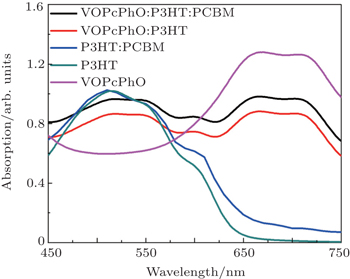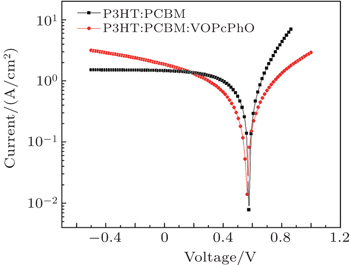† Corresponding author. E-mail:
This publication was made possible by PDRA (Grant No. PDRA1-0117-14109) from the Qatar National Research Fund (a member of Qatar Foundation). The findings achieved herein are solely the responsibility of the authors.
In this research, we report a bulk heterojunction (BHJ) solar cell consisting of a ternary blend system. Poly(3-hexylthiophene) P3HT is used as a donor and [6,6]-phenyl C61-butyric acid methylester (PCBM) plays the role of acceptor whereas vanadyl 2,9,16,23-tetraphenoxy-29H, 31H-phthalocyanine (VOPcPhO) is selected as an ambipolar transport material. The materials are selected and assembled in such a fashion that the generated charge carriers could efficiently be transported rightwards within the blend. The organic BHJ solar cells consist of ITO/PEDOT:PSS/ternary BHJ blend/Al structure. The power conversion efficiencies of the ITO/ PEDOT:PSS/P3HT:PCBM/Al and ITO/PEDOT:PSS/ P3HT:PCBM:VOPcPhO/Al solar cells are found to be 2.3% and 3.4%, respectively.
Organic materials have been investigated for the fabrication of solar cells in last few decades due to their flexibilities and solution processable natures. However, the efficiency of the organic solar cells is still low due to the limited absorption of the solar spectrum and relatively poor charge mobility. The bulk heterojuction (BHJ) of a p-type organic materials and a fullerene derivative are a possible way to be developed into efficient organic photovoltaic devices. The BHJ concept has been well thought out as a leading design for organic solar cells due to better efficiency, tunable properties and processing costs.[1–4] By this approach, the splitting of the photo-induced excitons is significantly improved and the exciton diffusion length issue has been resolved to some extent. However, in BHJ solar cells the optimum value of the active layer is very crucial. Although the thicker active layer can increase the optical absorption, the efficiency starts to decline after its certain critical value due to series resistance and charge recombination effects. This difficulty might be resolved by introducing the third component, resulting in optical absorption enhancement and charge transport improvement.[5,6]
A number of binary composite-based photovoltaic schemes have been proposed so far. P3HT and PCBM proved to be the best performing combination that has been regarded as being prominent for a decade.[7] P3HT exhibits a wide-ranging absorption in the visible region of the solar band, yet, there is a fraction of sunlight which must be involved to increase the efficiency of the organic solar cells. In our previous study, we reported a collection of BHJ blend systems for the potential applications in organic photovoltaic devices.[8–11] The efficiency of up to 9.32% has been stated for a bulk heterojunction solar cell of PCDTBT:PCBM,[12] which is very close to 10%, the minimum value required for real-world applications.[13]
Ternary blend based BHJ offers a diverse platform to improve the absorption. BHJ blend with the selectively localized organic dye component between BHJ boundaries has shown improved light harvesting due to both constituents i.e. dye and polymer donor material.[14] The organic dyes from phthalocyanine group exhibits strong absorption in the visible solar spectral regime.[15] For instance, vanadyl 2, 9, 16, 23-tetraphenoxy-29H, 31H-phthalocyanine (VOPcPhO) shows the main absorption band in a range of 600 nm–800 nm, where the P3HT captivates very little. Due to the interesting properties of VOPcPhO, the BHJ of P3HT and PCBM are doped by VOPcPhO, in this study, in order to prepare a ternary blend system for BHJ solar cells. It is expected that this combination will broaden the absorption range of P3HT:PCBM blend and could increase the charge generation in the ternary-blend-based solar cell.
In our experiment, regioregular poly(3-hexylthiophene-2,5-diyl) (P3HT), vanadyl 2,9,16,23-tetraphenoxy-29H, 31H-phthalocyanine (VOPcPhO), and [6,6]-phenyl C61 butyric acid methyl ester (PCBM) were purchased from Sigma-Aldrich, whereas the aqueous solution of the poly(3,4-ethylenedioxythiophene):poly(styrene sulfonate) (PEDOT:PSS) PH 1000 was purchased from H. C. Starck. Molecular structures of VOPcPhO, P3HT, and PCBM are shown in Fig.
The absorption spectra were taken using Shimadzu UV-3101PC spectrophotometer. The photoluminescence (PL) spectroscopy was performed using RENISHAW Microscope instrument. The I–V measurements were done under the AM1.5G-filtered irradiation by using Keithley-2400 source measuring unit (SMU). Atomic force microscopy (AFM) has been used to evaluate the morphology composite films. Figure
 | Fig. 1. (a) Molecular structures of VOPcPhO, P3HT, and PCBM, and (b) schematic diagram and an energy level diagram of the P3HT:VOPcPhO:PCBM-based solar cell. |
Photoluminescence (PL) spectra of P3HT, PCBM, VOPcPhO blend films are shown in Fig.
 | Fig. 4. UV-Vis spectra for the VOPcPhO, P3HT, P3HT:PCBM, VOPcPhO:P3HT, and VOPcPhO:P3HT:PCBM composite films. |
The photo absorption spectra of the blend thin films are shown in Fig.
In our previous studies,[15,19] we found that the VOPcPhO show the ambipolar charge transport. In order to discuss the detailed charge transport behavior of the VOPcPhO, first we describe the current–voltage (J–V) characteristics for the P3HT:VOPcPhO solar cells. The device exhibits nonlinear, asymmetric and rectification behavior. The reverse saturation current, ideality factor and shunt and series resistances for the P3HT:VOPcPhO solar cell are indicated in the inset of Fig.
In Fig.
 | Fig. 5. The J–V characteristics of ITO/PEDOT: PSS/P3HT:VOPcPhO/Al device under dark condition, plotted on a double log scale. The inset shows the dark J–V characteristics plotted on a semi-log scale. |
 | Fig. 6. The current–voltage characteristics of the ITO/PEDOT:PSS/P3HT:PCBM/Al and ITO/PEDOT:PSS/P3HT:PCBM: VOPcPhO/Al solar cells under 100-mW/cm2 incident light intensity. |
| Table 1. The photovoltaic characteristics for the ITO/PEDOT:PSS/ P3HT:PCBM/Al and ITO/PEDOT:PSS/P3HT: PCBM:VOPcPhO/Al photovoltaic devices. . |
A dye material VOPcPhO is added into the blend P3HT:PCBM as an ambipolar material. A significant increase in the short-circuit current is observed due to the absorption of light in the region where P3HT:PCMB blend cannot adsorb light. Finally, we conclude that the ternary blend system could be a promising fashion to be implemented in bulk heterojunction solar cells, together with electron acceptor component due to better charge transfer potential.
| 1 | |
| 2 | |
| 3 | |
| 4 | |
| 5 | |
| 6 | |
| 7 | |
| 8 | |
| 9 | |
| 10 | |
| 11 | |
| 12 | |
| 13 | |
| 14 | |
| 15 | |
| 16 | |
| 17 | |
| 18 | |
| 19 | |
| 20 | |
| 21 | |
| 22 |




